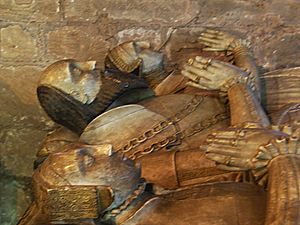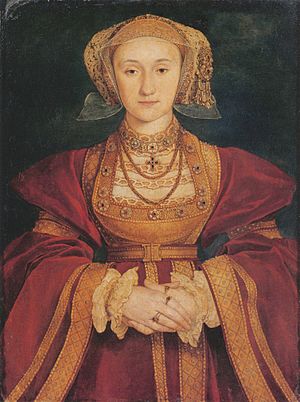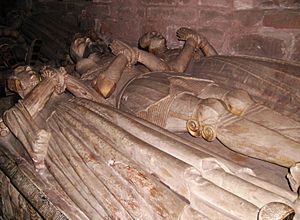Thomas Giffard facts for kids
Sir Thomas Giffard (born around 1491 – died May 27, 1560) was an important person during the Tudor period in England. He worked for the king, owned a lot of land in Staffordshire, and was a member of the English Parliament.
Contents
Who Was Thomas Giffard?
His Family and Early Life
Thomas Giffard's father was Sir John Giffard from Chillington Hall, near Brewood, Staffordshire. Sir John was a well-known person at the king's court and a soldier. He was also one of the richest landowners in the area. His family had lived at Chillington since the late 1100s.
Thomas Giffard's mother was Jane Horde. She was the daughter of a very important landowner in the Bridgnorth area. Sadly, she died in 1491, around the time Thomas was born.
His Education and First Marriage
Thomas Giffard had a short education in law. He studied at the Strand Inn and then the Inner Temple in London.
Around 1515, his father married again to Elizabeth Gresley. At the same time, Thomas Giffard married Dorothy, Elizabeth's daughter. Dorothy was about two years younger than him. She was going to inherit a lot of land from her family. This marriage helped Thomas become financially secure and independent from his father.
Becoming a Landowner
Even though Thomas Giffard lived a long life, he only outlived his father by four years. So, it was very lucky that he got land when he was young. Through his first wife, Dorothy, he became the lord of Cubley and Caverswall. Caverswall was a small area north-east of Stafford.
Thomas and Dorothy lived at Caverswall Castle. This remained Thomas's main home even after Dorothy died around 1529.
Managing Estates and Buying Land
Thomas Giffard didn't just wait to inherit his family's land. He also took on jobs managing other important landowners' properties. For example, he became the manager of Brewood Park. This was a large area of land belonging to the Bishop of Coventry and Lichfield. He earned money for this job. These kinds of jobs helped ambitious landowners get a foot in the door. Later, the Giffard family would even rent the park and make more money from managing it.
The Dissolution of Monasteries
In 1536, a new law called the Dissolution of the Lesser Monasteries Act was passed. This meant that many smaller monasteries were closed down. This created new chances for landowners like Giffard to buy property.
Soon, he wanted to buy Black Ladies Priory, a nunnery near Brewood that had been closed. Another local landowner, Sir Edward Littleton, also wanted it. The king's chief minister, Thomas Cromwell, decided that Thomas Giffard should get it. Giffard paid £134 for the property. It included the priory buildings, a churchyard, a water-mill, and grazing land. He built a new house there and seemed to live in it.
Important Roles in Staffordshire
Sir Thomas Giffard was important enough to be chosen as High Sheriff of Staffordshire three times: in 1529–30, 1547–8, and 1553–4. The High Sheriff was a very important local official. He was also a Justice of the Peace for Staffordshire from 1532 until he died. This meant he helped keep law and order.
He finally inherited the main Giffard family estates in 1556. This made him a very rich man for a short time.
Working for the King
A Gentleman at Court
Like his father, Thomas Giffard often visited the royal court. He became a Gentleman Usher of the Privy Chamber by 1533. This was a close position to the king, and he held it until he died. As someone the king trusted, he was also made a Ranger of Cannock forest along with his father.
Sometimes, Thomas and his father worked together for the king. In 1539, they were sent to get Dover and Sittingbourne castles ready for the arrival of Anne of Cleves. She was coming to meet King Henry VIII.
Fighting for the King
Like other people at court, Thomas Giffard also showed his loyalty by fighting for the king. In 1544, when he was at least 53 years old, he joined an army of 40,000 soldiers. They went to invade northern France as part of a war. However, the fighting got stuck in long sieges, and the war ended without a clear winner after a few months.
His Time in Parliament
First Time as an MP
Giffard was first elected to the English parliament in 1539. He was one of the two representatives for Staffordshire. The other member was Edward Littleton. This parliament lasted for just over a year. Its main job was to pass a law that closed down the larger monasteries.
After this, Giffard was not elected to parliament again until October 1553. This was the first parliament during the reign of Queen Mary I. He was known to be a traditional Catholic, like his father. He was knighted in 1547, just after King Edward VI became king. It seems that local politics made it harder for him to get a seat in parliament.
Later Parliaments and Religious Choices
In the election of September 1553, Giffard was chosen by "every man's voice." This meant he was elected easily. He served with Edward Littleton again. This parliament only lasted two months. Giffard was not elected to the next two parliaments in 1554 because he was serving as Sheriff. However, he was able to help his own son, John, become a member of parliament for Stafford.
Giffard was elected to parliament again in late 1555, once more with Littleton. Both were Catholic and generally followed what the queen wanted. They supported Queen Mary's laws. However, Giffard lived longer than Queen Mary. When Queen Elizabeth I became queen and brought in new Protestant laws, Giffard had to make a choice. He asked for a pardon from the new queen, showing he was still Catholic. This was a big decision for the Giffard family, who remained Catholic for many generations.
His Marriages and Children
- Dorothy Montgomery was Thomas Giffard's first wife. She was the daughter of Sir John Montgomery. Thomas married Dorothy around 1515. She brought him a lot of land in Staffordshire and Derbyshire. Dorothy died by 1529. They had at least one daughter, Elizabeth, but no sons.
- Ursula Throckmorton was Giffard's second wife. She was the daughter of Robert Throckmorton. Her brother, George Throckmorton, was a politician who strongly supported the Catholic faith. Thomas Giffard had at least nine children with Ursula:
* John Giffard, who inherited Thomas's estates. * Edward Giffard * Humphrey Giffard * Robert Giffard * Dorothy Giffard * Isabella Giffard * Cassandra Giffard * Elizabeth Giffard * Anne Giffard
Sir Thomas Giffard died on May 27, 1560. He was buried in Brewood parish church. A large tomb was built later, with statues of him and both his wives.
Images for kids






